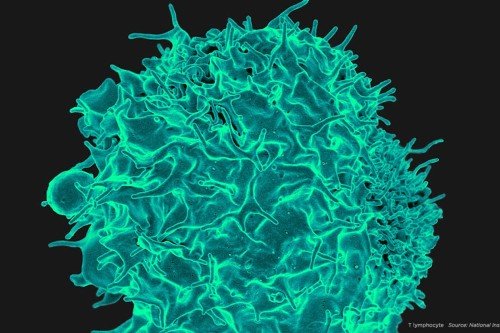
Scientists at the Sloan Kettering Institute are learning why some immune cells are stubbornly hard to revive with immunotherapy.
A paradox lies at the heart of cancer. Coursing through many tumors are legions of immune cells, including the T cells that should be fighting the cancer. Yet these T cells are typically dysfunctional — they stop working and let the tumor grow with abandon.
Scientists have a name for this conundrum: the Hellström paradox, after Ingegerd and Karl Hellström, the immunologists who first drew attention to it more than 50 years ago.
As for why immune cells turn a blind eye to the deadly threat growing in their midst, researchers still aren’t entirely sure. But a picture is starting to emerge.
“T cells go through successive waves of differentiation,” says Mary Philip, a physician-scientist who studies dysfunctional T cells in the lab of Andrea Schietinger at the Sloan Kettering Institute. Using mouse models of cancer, she and her colleagues have found that T cells become dysfunctional early on during tumor development, but their fate is still plastic at this point; they can be reprogrammed to fight the cancer. Later on, after further differentiation, the cells become much more settled in their ways. “Once they enter this fixed dysfunctional state, it’s very hard to reprogram them to fight the disease,” she says.
That’s a problem for approaches to cancer treatment that rely on using drugs to prod the immune system into attacking cancer. From the standpoint of immunotherapy, these dysfunctional T cells are essentially a lost cause.
But what if there were a way to tease apart that dysfunction, and learn why it happens in the first place? In a new paper published in Nature, Dr. Philip and her colleagues unravel a mechanism of T cell dysfunction. Their research reveals new potential biomarkers of response to immunotherapy, and even suggests ways to try to nudge the stalled cells back into responsiveness.
Pinpointing Dysfunction
“We’re all really excited about immunotherapy,” says Dr. Philip, an oncologist who also conducts laboratory research. “When it works, it works really well. You have patients with metastatic cancer who are essentially being cured.”
The problem, she notes, is that this happens in only a fraction of patients, maybe 20%, and in only some types of cancer. The rest either don’t respond, or their responses don’t last.
“That’s challenged us to try to understand what is the difference between a patient who has a good response and one who does not,” she adds. One aspect of that problem may be deciphering the difference between a dysfunctional T cell that can be rescued with immunotherapy, and one that cannot.
To tackle this problem, the Schietinger lab turned to clues they uncovered in previous experiments. Whatever eventually happens to T cells in tumors is stubbornly hard to undo. “Even if you take them out and you park them in a totally normal environment, they still do not recover,” Dr. Schietinger says. “That implies it’s something epigenetically imprinted.”
By that, she means changes to the way that DNA is packaged in cells, wrapped up with proteins called histones to form chromatin. This chromatin packaging can influence how accessible certain genes are to being turned on or off in a cell. And these chromatin states can be passed from cell to cell and maintained over time, even without additional signals coming from the cells’ surroundings.
To test this hypothesis that dysfunction is related to chromatin states, the Schietinger lab — in collaboration with their computational and clinical collaborators — performed experiments to look at which regions of the genome in tumor-infiltrating T cells were “open” and which regions were “closed.” They used a technique called ATAC-seq that uncovers regions of the genome where the DNA is accessible.
They found that specific chromatin states did indeed correlate with whether the T cell dysfunction was plastic or fixed. “For T cells to be functional, we know there are important genes that need to be open — for example, interferon gamma — and we show that they are actually not,” Dr. Schietinger says. Likewise, she notes, genes for inhibitory receptors that shut T cells down were suddenly wide open.
What’s more, the team identified cell surface markers that closely correlated with these internal chromatin changes as well as with the T cell’s therapeutic reprogrammability — and that’s why the researchers are so excited about this work.
“Everyone right now in immunotherapy is trying to find markers that could tell us whether a T cell is therapeutically reprogrammable or not,” Dr. Schietinger says. “PD-1 for example is a marker on immune cells to which several immunotherapy drugs are directed. But when we look at PD-1 expression in these T cells, they are all PD-1 high regardless of whether the T cell is in a plastic or fixed state. So the PD-1 marker is not really reflecting whether the cells are reprogrammable or not.”
Potential New Biomarkers
While the researchers did their experiments in mice, they also showed that T cells from tissue samples taken from patients with lung cancer and melanoma resembled the fixed, dysfunctional variety found in mice, and also expressed these biomarkers.
The tantalizing implication of this research is that these previously unknown biomarkers of plastic versus fixed dysfunction might identify which patients are more likely to respond to immunotherapy.
“Perhaps patients who do respond to checkpoint blockade [a class of immunotherapy drug] have more of the T cells that are in the plastic state and can be reprogrammed, versus patients who don’t respond,” Dr. Philip says.
The idea is speculative. “We haven’t shown that directly in this paper, but we are working on it,” she says.
If the idea pans out, Dr. Schietinger says, it “opens the door for clinicians to zoom into a T cell and say, ‘You are PD-1 high, but let’s now look at these other markers and see whether you need something else as well, besides checkpoint blockade, to get you going and attack the tumor.’”
What might that something else be? Possibly, one could breathe life back into dysfunctional T cells by adding drugs that target specific transcription factors, which control cell differentiation and which the team identified to be critical for the dysfunctional chromatin states.
The researchers found that giving mice two such drugs could block T cells from entering the fixed dysfunctional state. These cells were then more easily reprogrammable to become cancer fighters in their models.
To Dr. Schietinger, this suggests that perhaps adding this type of drug alongside checkpoint inhibitors would allow more patients to respond. It’s too soon to say for sure that this is the case, but work they are doing now should help to answer the question.




